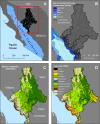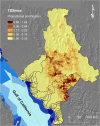Advancing Land-Sea Conservation Planning: Integrating Modelling of Catchments, Land-Use Change, and River Plumes to Prioritise Catchment Management and Protection
- PMID: 26714166
- PMCID: PMC4695094
- DOI: 10.1371/journal.pone.0145574
Advancing Land-Sea Conservation Planning: Integrating Modelling of Catchments, Land-Use Change, and River Plumes to Prioritise Catchment Management and Protection
Abstract
Human-induced changes to river loads of nutrients and sediments pose a significant threat to marine ecosystems. Ongoing land-use change can further increase these loads, and amplify the impacts of land-based threats on vulnerable marine ecosystems. Consequently, there is a need to assess these threats and prioritise actions to mitigate their impacts. A key question regarding prioritisation is whether actions in catchments to maintain coastal-marine water quality can be spatially congruent with actions for other management objectives, such as conserving terrestrial biodiversity. In selected catchments draining into the Gulf of California, Mexico, we employed Land Change Modeller to assess the vulnerability of areas with native vegetation to conversion into crops, pasture, and urban areas. We then used SedNet, a catchment modelling tool, to map the sources and estimate pollutant loads delivered to the Gulf by these catchments. Following these analyses, we used modelled river plumes to identify marine areas likely influenced by land-based pollutants. Finally, we prioritised areas for catchment management based on objectives for conservation of terrestrial biodiversity and objectives for water quality that recognised links between pollutant sources and affected marine areas. Our objectives for coastal-marine water quality were to reduce sediment and nutrient discharges from anthropic areas, and minimise future increases in coastal sedimentation and eutrophication. Our objectives for protection of terrestrial biodiversity covered species of vertebrates. We used Marxan, a conservation planning tool, to prioritise interventions and explore spatial differences in priorities for both objectives. Notable differences in the distributions of land values for terrestrial biodiversity and coastal-marine water quality indicated the likely need for trade-offs between catchment management objectives. However, there were priority areas that contributed to both sets of objectives. Our study demonstrates a practical approach to integrating models of catchments, land-use change, and river plumes with conservation planning software to inform prioritisation of catchment management.
Conflict of interest statement
Figures









Similar articles
-
Modeling catchment nutrients and sediment loads to inform regional management of water quality in coastal-marine ecosystems: a comparison of two approaches.J Environ Manage. 2014 Dec 15;146:164-178. doi: 10.1016/j.jenvman.2014.07.007. Epub 2014 Aug 28. J Environ Manage. 2014. PMID: 25173725
-
A novel approach to model exposure of coastal-marine ecosystems to riverine flood plumes based on remote sensing techniques.J Environ Manage. 2013 Apr 15;119:194-207. doi: 10.1016/j.jenvman.2013.01.036. Epub 2013 Mar 22. J Environ Manage. 2013. PMID: 23500022
-
A modelling approach to assess the impact of land mining on marine biodiversity: Assessment in coastal catchments experiencing catastrophic events (SW Brazil).Sci Total Environ. 2019 Apr 1;659:828-840. doi: 10.1016/j.scitotenv.2018.12.238. Epub 2018 Dec 18. Sci Total Environ. 2019. PMID: 31096413
-
Marine Biodiversity, Biogeography, Deep-Sea Gradients, and Conservation.Curr Biol. 2017 Jun 5;27(11):R511-R527. doi: 10.1016/j.cub.2017.04.060. Curr Biol. 2017. PMID: 28586689 Review.
-
A review of sediment and nutrient concentration data from Australia for use in catchment water quality models.Mar Pollut Bull. 2012;65(4-9):101-16. doi: 10.1016/j.marpolbul.2011.08.009. Epub 2011 Sep 1. Mar Pollut Bull. 2012. PMID: 21889170 Review.
Cited by
-
Increased sediment loads cause non-linear decreases in seagrass suitable habitat extent.PLoS One. 2017 Nov 10;12(11):e0187284. doi: 10.1371/journal.pone.0187284. eCollection 2017. PLoS One. 2017. PMID: 29125843 Free PMC article.
-
Avoiding Implementation Failure in Catchment Landscapes: A Case Study in Governance of the Great Barrier Reef.Environ Manage. 2018 Jul;62(1):70-81. doi: 10.1007/s00267-017-0932-2. Epub 2017 Oct 4. Environ Manage. 2018. PMID: 28980059
-
Landscape-scale conservation design across biotic realms: sequential integration of aquatic and terrestrial landscapes.Sci Rep. 2017 Nov 6;7(1):14556. doi: 10.1038/s41598-017-15304-w. Sci Rep. 2017. PMID: 29109425 Free PMC article.
-
Integrating climate adaptation and biodiversity conservation in the global ocean.Sci Adv. 2019 Nov 27;5(11):eaay9969. doi: 10.1126/sciadv.aay9969. eCollection 2019 Nov. Sci Adv. 2019. PMID: 31807711 Free PMC article.
-
Simple rules can guide whether land- or ocean-based conservation will best benefit marine ecosystems.PLoS Biol. 2017 Sep 6;15(9):e2001886. doi: 10.1371/journal.pbio.2001886. eCollection 2017 Sep. PLoS Biol. 2017. PMID: 28877168 Free PMC article.
References
-
- Worm B, Barbier EB, Beaumont N, Duffy JE, Folke C, Halpern BS, et al. Impacts of biodiversity loss on ocean ecosystem services. Science. 2006;314(5800):787–90. - PubMed
-
- Walling DE. Human impact on land-ocean sediment transfer by the world's rivers. Geomorphology. 2006;79(3–4):192–216.
Publication types
MeSH terms
LinkOut - more resources
Full Text Sources
Other Literature Sources

